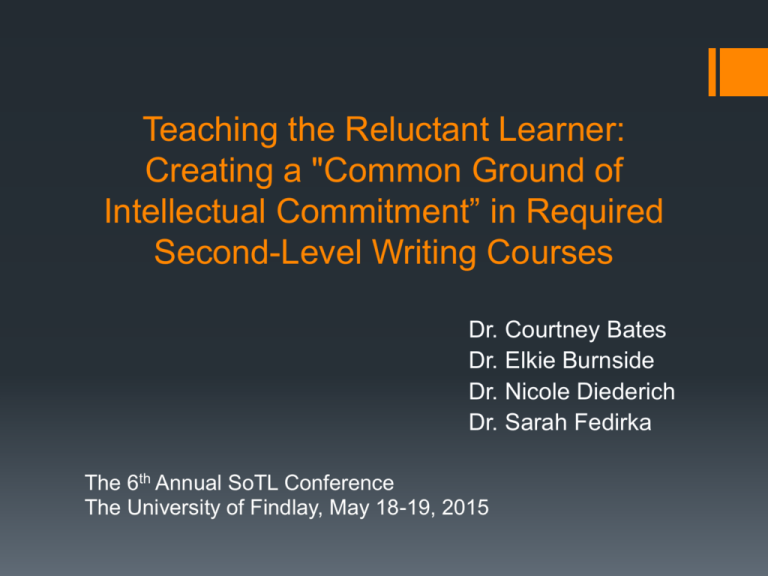Presentation - The University of Findlay
advertisement

Teaching the Reluctant Learner: Creating a "Common Ground of Intellectual Commitment” in Required Second-Level Writing Courses Dr. Courtney Bates Dr. Elkie Burnside Dr. Nicole Diederich Dr. Sarah Fedirka The 6th Annual SoTL Conference The University of Findlay, May 18-19, 2015 What a teacher does matters. Great teachers “create a common ground of intellectual commitment. They stimulate active, not passive, learning and encourage students to be critical, creative thinkers, with the capacity to go on learning after their college days are over.” (Boyer, 1990, p. 24) What a teacher knows matters. “As a scholarly enterprise, teaching begins with what the teacher knows.” (Boyer, 1990, p. 23) A teacher must know his or her students. “An essential component of facilitating learning is understanding learners.” (Oblinger, 2013, p. 37) Boyer’s students were Gen-X. The Berlin Wall fell AIDS and the Web emerged The Chernobyl nuclear accident occurred The Exxon Valdez caused an oil spill The Challenger space shuttle exploded The first computer disk was sold (Oblinger, 2013, p. 38) Our students are Millennials. Ads for prescription drugs, noting their disturbing side effects, have always flooded the airwaves One route to pregnancy has always been through frozen eggs “Press pound” on the phone is now translated as “hit hashtag” Celebrity “selfies” are far cooler than autographs (Neif and McBride, 2014) How Millennials experience the world shapes how they learn. “Computers aren’t technology” “The Internet is better than TV” “Reality is no longer real” “Doing is more important than knowing” ”Multitasking is a way of life” “Staying connected is essential” “Consumer and creator are blurring” (Oblinger, 2013, p. 40-41) Five shared learning outcomes for second writing courses: analyze, critique, and respond to texts and/or rhetorical situations apply theoretical and critical concepts in a variety of composing spaces conceptualize, plan, draft, and revise texts conduct appropriate academic/professional research use correctly at least one formal method of documentation. How Millennials experience college shapes the future of higher education. 62% of Net-Gen students say their undergraduate education has “paid off” (DeSilver, 2014) “30% of 2013 graduates say on balance they would be better off not having gone to college” (Bourneuf, 2014) “22.9% of entering students at four-year institutions think there is either ‘some’ or a ‘very good’ chance they will transfer to another institution” (Eagan, K., Stolzenberg, E. B., Ramirez, J. J., Aragon, M. C., Suchard, M. R., & Hurtado, S., 2014, p. 6) What a teacher does matters. “Student engagement is generally acknowledged as a key factor in student retention, and enhancing student engagement is a fundamental strategy for improving student retention, success and outcomes.” (Crosling, G., Heagney, M., and Thomas, L., 2009, p. 10) “Students benefit from collaborative learning situations, where learning is active and interactive between students and their peers in and outside the classroom, as well as with the teachers. Formative assessment is crucial, providing immediate and relevant information for students’ academic development needs at the particular point in time.” “There is a body of evidence from the US (and increasingly in other countries) that the more students interact with other students and staff, the more likely they are to persist.” (Crosling, G., Heagney, M., and Thomas, L., 2009, p. 11-12) What a teacher knows matters. “Teaching is also a dynamic endeavor involving all the analogies, metaphors, and images that build bridges between the teacher’s understanding and the student’s understanding.” (Boyer, 1990, p.23) References Albers, C. (2008, June). Improving pedagogy through action learning and scholarship of teaching and learning. Teaching Sociology, 36 (1), 79-86. Retrieved from http://www.jstor.org/stable/20058630 Boyer, E. L. (1990) Scholarship Reconsidered: Priorities of the Professoriate. The Carnegie Foundation for the Advancement of Teaching. Retrieved from https://depts.washington.edu/gs630/Spring/Boyer.pdf Bourneuf, J. (2014) The 2014 retention imperative: a white paper. Retrieved from http://www.askonline.net/2014/02/1774/ Crosling, G., Heagney, M., and Thomas, L. (2009) Improving student retention in higher education: improving teaching and learning. Australian Universities’ Review 51(2), pp. 918. Retrieved from http://www.universityworldnews.com/filemgmt_data/files/A UR_51-02_Crosling.pdf DeSilver, Drew. (2014) 5 facts about today’s college graduates. FactTank: News in the Numbers. Pew Research Centers Retrieved from http://www.pewresearch.org/facttank/2014/05/30/5-facts-about-todays-college-graduates/ Eagan, K., Stolzenberg, E. B., Ramirez, J. J., Aragon, M. C., Suchard, M. R., & Hurtado, S. (2014). The American freshman: National norms fall 2014. Los Angeles: Higher Education Research Institute, UCLA. Retrieved from http://www.heri.ucla.edu/monographs/theamericanfreshma n2014.pdf Kreber, C. & Cranton, P. A. (2000, July-Aug). Exploring the scholarship of teaching. The Journal of Higher Education, 71 (4), 476-495. Retrieved from http://www.jstor.org/stable/2649149 Lau, L. (2003). Institutional factors affecting student retention. Education, 124 (1), 126-136. Retrieved from http://www.uccs.edu/Documents/retention/2003%20Instituti onal%20Factors%20Affecting%20Student%20Retention.pd f Oblinger, D. (2003) Boomers, Gen-Xers, and Millennials: understanding the new students. Educause Review. Retrieved from https://net.educause.edu/ir/library/pdf/ERM0342.pdf Neif, R. and McBride, T. (2014) Beloit College 2018 list. Retrieved from http://www.beloit.edu/mindset/2018/ Skiba, D. J. & Barton, A. J. (2006, May). Adapting your teaching to accommodate the net generation of learners. OJIN: The Online Journal of Issues in Nursing, 11 (2), manuscript 4. doi: 10.3912/OJIN.Vol11No02Man04 Spelt, E.J.H., Biemans, H.J.A., Tobi, H. Luning, P. A., & Mulder, M. (2009, December). Teaching and learning in interdisciplinary higher education: A systematic review. Educational Psychology Review 21 (4), 365-378. Retrieved from http://www.jstor.org/stable/23361570



